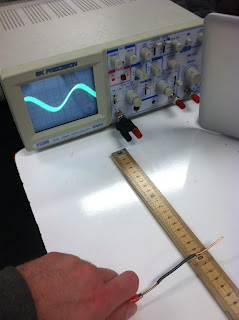Purpose: determine the characteristics of sound waves such as the period, frequency wavelength, speed, amplitude. Then test variations of its frequencies by having different people speak into the microphone.
Materials:
- Lab Pro microphone
- computer
Experiment:
1. Say “AAAAAAAA” smoothly into
the microphone and hit Collect. Once
you get a graph that you think is quality, copy it to a Word document and label
it #1. Answer the following questions in
your document.
a) Would
you say this is a periodic wave? Support
your answer with characteristics.
b) How
many waves are shown in this sample?
Explain how you determined this number.
c) Relate
how long the probe collected data to something in your everyday experience. For
example: “Lunch passes by at a snails pace.” Or “Physics class flies by as fast
as a jet by the window.”
d) What
is the period of these waves? Explain
how you determined the period.
e) What
is the frequency of these waves? Explain
how you determined the frequency.
f) Calculate
the wavelength assuming the speed of sound to be 340 m/s. Relate the length of
the sound wave to something in the class room.
g) What
is the amplitude of these waves? Explain
how you determined amplitude.
h) What
would be different about the graph if the sample were 10 times as long? How
would your answers for the questions a-g change? Explain your thinking. Change
the sample rate and test your ideas. Copy the graph and label it #1h.
2. Now have someone else in your group say
“AAAAAA” into the microphone. Copy the
graph and label it #2. Compare and
contrast the two people’s wave patterns.
Be specific in your answer. For example: determine the characteristics
that you did for the first person (# of waves, frequency, period, amplitude,
and wavelength) and include any qualitative observations.
|
# of waves |
frequency (Hz) |
period (s) |
amplitude (arbs.) |
wavelength (m) |
| Trial 1 |
4 |
154 |
0.0065 |
0.7715 |
2.21 |
| Trial 2 |
4 |
125 |
0.0080 |
0.7560 |
2.72 |
The first trial was a female voice and the second trial was a male voice. The male voice had a lower pitch which accounted for the lower frequency and larger wavelength.
3. Collect data for a tuning fork by striking it
on a soft object. Copy the graph and label it #3. Compare and contrast the waves made by human
voice.
|
# of waves |
frequency (Hz) |
period (s) |
amplitude (arbs.) |
wavelength (m) |
| Trial 1 |
4 |
154 |
0.0065 |
0.7715 |
2.21 |
| Trial 3 |
12 |
400 |
0.0025 |
0.1620 |
0.85 |
In the same amount of time collected, the tuning fork made 3 times as more waves as the first person did. The frequency was 3 times as higher and the wavelength was 3 times as smaller.
4. If you use the same tuning fork to collect
data for a sound that is not as loud, what changes would you expect on the
display from the sample in #3? Test your
ideas. Copy the graph and label it #4. What did you do to make the sound
softer? Compare and contrast the waves
collected for the louder sound.
We tapped it lighter on our hands to make the sounds softer. We expected all the characteristics to be the different.
|
# of waves |
frequency (Hz) |
period (s) |
amplitude (arbs.) |
wavelength (m) |
| Trial 3 |
12 |
400 |
0.0025 |
0.1620 |
0.85 |
| Trial 4 |
7 |
250 |
0.0040 |
0.2835 |
1.36 |
Everything changed in the softer wave. Since the frequency changed all the other characteristics changed with it.







.JPG)
.JPG)



















.png)


